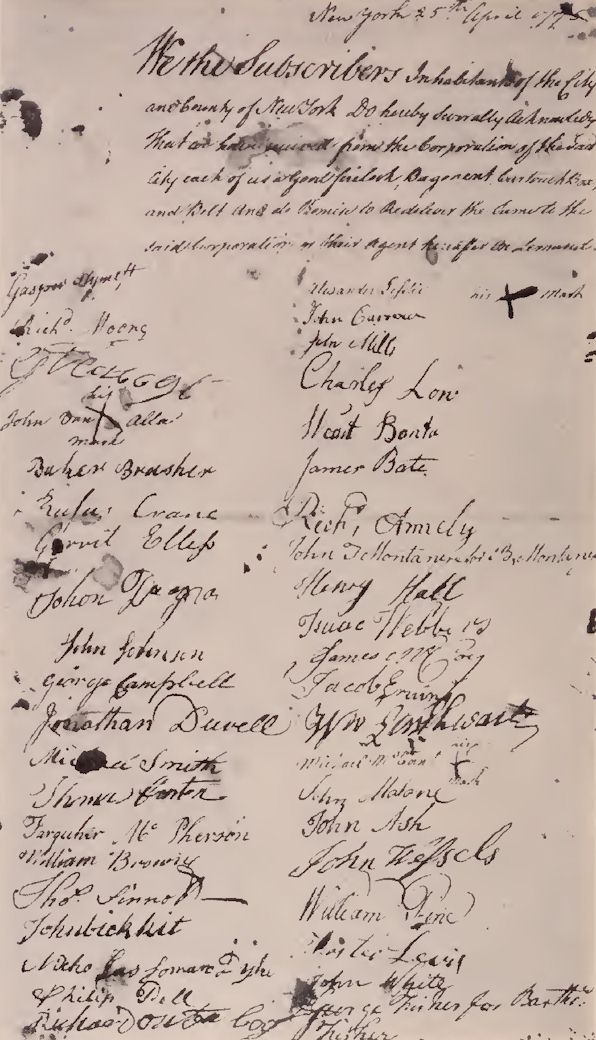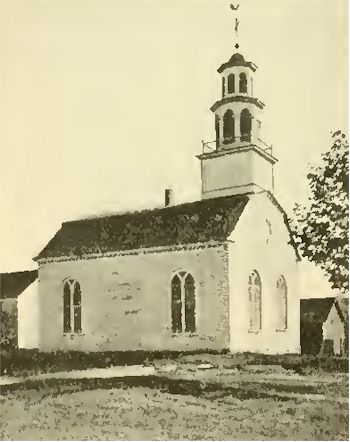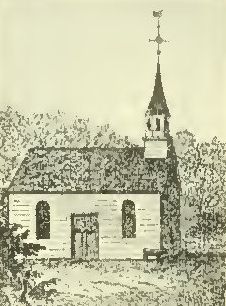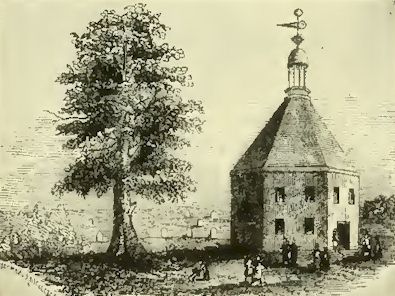|
 |

Part of the American
History & Genealogy Project |
Mohawk Valley to the End

Palatine
Palatine, now known as Palatine Bridge,
on the north side of the Mohawk and opposite Canajoharie, was
one of the homes of the Palatines, as its name would indicate.
The first settler in this town, and possibly the first west of
Schenectady, was Heinrich Prey, a native of Switzerland, who
occupied and laid claim to a tract of land there about 1690. The
old homestead is still in possession of the family. The present
house was erected in 1739, having been preceded by a log cabin.
The Frey house is built of stone and is
on the right hand side of the Central road in going west, just a
little to the west of Palatine Bridge.

The Old Frey House at Palatine
Fort
Plain
Fort Plain was situated upon high ground
at the rear of the present village of the same name. It was of
some importance in the early days, affording protection to the
inhabitants of that vicinity. The cut of the old blockhouse
there will give some idea of the means of defense on the
frontier at that time. During the Revolution the government
erected at this place a fort that was stronger than any other in
that section of the country. It was used as a place of deposit
for military stores for some years after the close of the war.
The
Palatine
Church
Three miles to the east of the village
of St. Johnsville is the old Lutheran meeting-house known as the
Palatine Church. It is a little to the north of the track of the
Central Railroad and in plain sight to all who pass.
The church was built of stone and is in
perfect condition to-day. It was dedicated August 18, 1770, and
from that time till the present has been in constant use for
religious purposes. On the 1 8th of August. 1870. The centenary
anniversary of the dedication of this church was appropriately
observed. More than five thousand people were present. Addresses
were made by Reverend Charles A. Smith, who had been a pastor of
the church more than half a century before; Prof. Geortner, of
Hamilton College, and Governor Horatio Seymour.

Ancient Blockhouse, Fort Plain
The cost of erecting the church was
borne by a small number of people. The lot was given by Hendrick
W. Nellis, and Henry Nellis paid for building the steeple. The
cost of the church exclusive of the gift of these two men was
about six hundred seventy pounds, a very large sum for those
times. William, Andrew, Johannes, Henry, Christian, and David
Nellis, sons of the before mentioned Hendrick and Henry Nellis,
gave sixty pounds each toward the erection of the church, and
Johannes Hess gave a like sum. The remainder of the expense,
about two hundred pounds, was borne equally by Peter Waggoner
and Andrew Reber.
In the spire was one of three noted
triangles which was used to call the people together for
service. One of the others was in the old Canajoharie Academy,
and the third is still in use in the Court House in Johnstown.
Danube
The Indian Castle Church was situated in
the town of Danube. Herkimer County, on the site of an early
Indian mission. King Hendrick lived near here. The home of
General Herkimer was in Danube and his house is still standing,
an illustration showing the same being given elsewhere in this
volume. The Indian Castle Church was built for the Indians
before the Revolution, chiefly through the efforts of Sir
William Johnson. There is still a small church on the old site
which bears the name of Indian Castle Church.

The Palatine Church
Steuben
The town of Steuben in Oneida county was
settled principally by the Welsh. The greater part of the town
was given to Baron Steuben by the State of New York in
recognition of his services during the Revolution. Congress gave
him an annuity of $2,500 a year. He lived on his estate in the
town of Steuben till his death on the 28th of November, 1794.
Steuben served many years in the army of
Frederick the Great. He was one of the aids of the great general
and held the rank of lieutenant-general. He came to this country
in 1777, and offered his services to Congress, not asking any
rank. He was made inspector general with the rank of
major-general.
On the walls of a German Lutheran church
in the city of New York is the following inscription:
"Sacred to the memory of Frederick
William Augustus Baron Steuben, a German; knight of the order of
Fidelity; aide-de-camp to Frederick the Great, King of Prussia;
major-general and inspector-general in the Revolutionary War;
esteemed, respected, and supported by Washington. Fie gave
military skill and discipline to the citizen soldiers, who,
fulfilling the decrees of heaven, achieved the independence of
the United States. The highly polished manners of the baron were
graced by the noblest feelings of the heart. His hand, open as
the day for melting charity, closed only in the strong hand of
death. This memorial is inscribed by an American, who had the
honor to be his aide-de-camp, and the happiness to be his
friend." The place where Steuben lived is now known as
Steubenville.

Indian Castle Church
German Flatts
German Flatts, now Herkimer, was settled
almost wholly by the Palatines. By 175 1 there had grown up a
settlement of sixty dwellings and three hundred inhabitants. For
many years the Palatines prospered, but on the 12th of November,
1757. M. de Belletre, with a party of marines, Canadians and
Indians numbering about three hundred, destroyed the Palatine
settlement. At this time the village contained sixty-five houses
and five blockhouses, all of which were burned. Though the
inhabitants surrendered without resistance a considerable number
was killed and about one hundred carried into captivity. Their
property was destroyed and their stock killed or driven off. The
following spring the Palatines south of the river were attacked
by the French and Indians and several were killed, but the enemy
was finally driven off. The year following brought another
period of peace. The captured Palatines returned to their
friends, rebuilt their homes, restocked their farms, and began
another period of prosperity which lasted till the outbreak of
the Revolution.
There were two forts in the Palatine
settlement, Fort Dayton on the north side of the river within
the boundaries of the present village of Herkimer, and Fort
Herkimer on the south side of the river and near its bank. There
were about seventy dwellings within the vicinity of these two
forts.
On the 1st of September, 1778, Brant
with a force of about four hundred fifty Tories and Indians
attacked the place. The people escaped to the forts, but their
property was destroyed. Houses, barns, grist and saw-mills,
horses, cattle and sheep, all the fruits of their industry for
many years, vanished in a few hours.
The Palatines bore much to maintain a
principle. Twice their ancestors had suffered the extreme
horrors of war on another continent in the last half of the
seventeenth century, and twice in the last half of the
eighteenth the homes of these people had been destroyed, and
their farms laid waste in the new world.
Johnson held several councils with the
Indians at German Flatts, one very important one in 1770 at
which more than two thousand Indians, representing the Six
Nations and the Cherokees, were present.
The first liberty pole erected in the
Mohawk valley was raised at Fort Herkimer in 1775. At an early
day a church was erected at German Flatts for the use of white
people. There had been an earlier mission church for the
Indians.
Little
Falls
The grist mill at this place was of much
importance to the early settlers of the upper valley, and also
to the people at Forts Herkimer and Dayton after the destruction
of German Flatts; and the burning of the mill by the Indians and
Tories in June, 1782, was a serious misfortune.

Octagon Church, Little Falls
A church was erected at Little Falls as
early as 1796. It was of no historical importance, but is of
interest as illustrating church construction of the time on the
frontier, not that this type was common, but it shows how simply
the people built then.
The first building erected within the
limits of the present city of Utica was a mud fort, situated
between Main Street and the river. It was known as Fort Schuyler
and is of interest now chiefly because it is sometimes
confounded with the fort built at Rome, which was at first
called Fort Stanwix, but during the Revolution was known as Fort
Schuyler.
Fort
Stanwix
Fort Stanwix was situated within the
heart of the present city of Rome. It was built by General
Stanwix after the defeat of Abercrombie at Ticonderoga, and was
given the name of its builder. It was a square fortification of
considerable strength and so placed as to command the portage
between the Mohawk and Wood Creek, the latter being a stream
flowing into Oneida Lake. There were several smaller works in
the vicinity, the most important being Fort Newport on Wood
Creek, and Fort Bull about midway between Forts Stanwix and
Newport. At the time of the beginning of the Revolution Fort
Stanwix, upon which more than a quarter of a million of dollars
had been expended, an immense sum for those times, was in ruins.
It was repaired and named Fort Schuyler. The first American flag
floated from this fort, it being made from materials at hand.
The importance of this fort has been shown in the account given
of the battle of Oriskany.
A treaty of peace and amnesty was
concluded between the Six Nations and the United States at Fort
Stanwix in 1784. This resulted in setting at liberty many
prisoners that had been held by the Indians.
In 1768 an important council was held
here, in which representatives of Virginia, Pennsylvania and New
Jersey met thirty-two hundred Indians of the Six Nations. The
treaty concluded at that time was known as the "Treaty of Fort
Stanwix."
During the
Revolution
The Dutch and Germans were ardent Whigs,
while the Highlanders and other retainers of the Johnsons formed
the bulk of the Tories. Johnson organized his followers into a
body known as "Johnson's Greens," who were the bitterest and
cruelest of all the foes of the patriots, not even excepting the
Indians. Most of the Six Nations cast their lot with the
British, though the Oneidas and a few others remained neutral or
sided with the patriots. Among the most active and efficient of
the patriots were General Herkimer and the missionary Samuel
Kirkland. Jacob Klock, Ebenezer Cox, Samuel Campbell, and many
others were untiring in their efforts.
The colonists of the Upper Mohawk, who,
almost to a man, were patriots, were cut off from ready
communication with other Whigs by the intervening district of
Mohawk, which was completely under the domination of the
Johnsons.
In no other part of our country were the
Tories so active and so malignant, or the Whigs so loyal and
faithful, as in the valley of the Mohawk. In no other section
did the Whigs suffer so severely in the cause of liberty. The
story of the long struggle in the valley is one of intense
interest. It has been briefly sketched in these pages, but the
reader should not be content without fuller knowledge. He should
read such works as "The Life of Sir William Johnson" and "The
Life of Brant," by Stone; "The Annals of Tryon County," by
Campbell; "The Old New York Frontier," by Halsey; "The History
of Herkimer County," by Benton; "The History of Schoharie
County," by Simms, and the many other volumes which the reading
of these will suggest.
Mohawk Valley
| AHGP New York

Source: Stories from Early New York
History, by Sherman Williams, New York, Charles Scribner's Sons,
1906
|